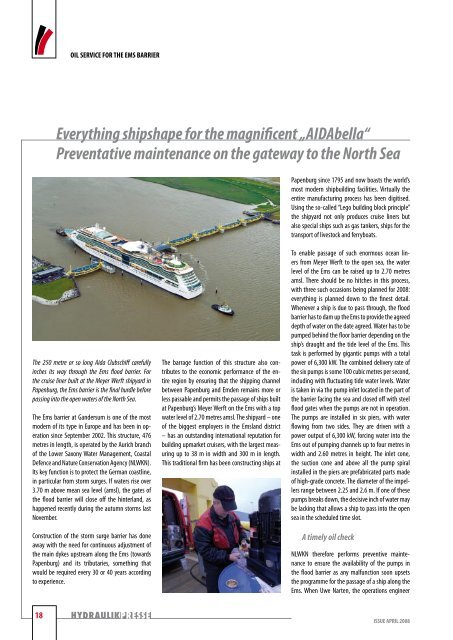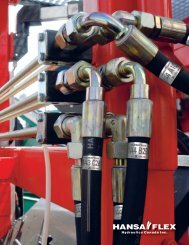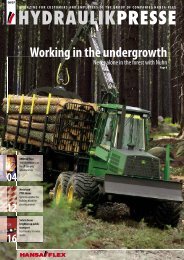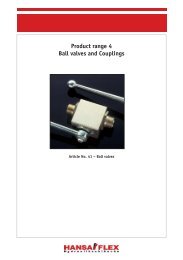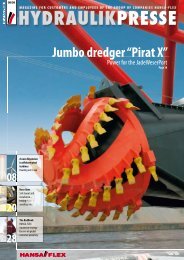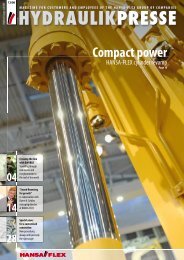hydraulik - HANSA-FLEX Hydraulics Canada Inc.
hydraulik - HANSA-FLEX Hydraulics Canada Inc.
hydraulik - HANSA-FLEX Hydraulics Canada Inc.
You also want an ePaper? Increase the reach of your titles
YUMPU automatically turns print PDFs into web optimized ePapers that Google loves.
HYDRAULIKPRESSE<br />
OIL SERVICE FOR THE EMS BARRIER<br />
Everything shipshape for the magnificent „AIDAbella“<br />
Preventative maintenance on the gateway to the North Sea<br />
Papenburg since 1795 and now boasts the world’s<br />
most modern shipbuilding facilities. Virtually the<br />
entire manufacturing process has been digitised.<br />
Using the so-called “Lego building block principle”<br />
the shipyard not only produces cruise liners but<br />
also special ships such as gas tankers, ships for the<br />
transport of livestock and ferryboats.<br />
The 250 metre or so long Aida Clubschiff carefully<br />
inches its way through the Ems flood barrier. For<br />
the cruise liner built at the Meyer Werft shipyard in<br />
Papenburg, the Ems barrier is the final hurdle before<br />
passing into the open waters of the North Sea.<br />
The Ems barrier at Gandersum is one of the most<br />
modern of its type in Europe and has been in operation<br />
since September 2002. This structure, 476<br />
metres in length, is operated by the Aurich branch<br />
of the Lower Saxony Water Management, Coastal<br />
Defence and Nature Conservation Agency (NLWKN).<br />
Its key function is to protect the German coastline,<br />
in particular from storm surges. If waters rise over<br />
3.70 m above mean sea level (amsl), the gates of<br />
the flood barrier will close off the hinterland, as<br />
happened recently during the autumn storms last<br />
November.<br />
Construction of the storm surge barrier has done<br />
away with the need for continuous adjustment of<br />
the main dykes upstream along the Ems (towards<br />
Papenburg) and its tributaries, something that<br />
would be required every 30 or 40 years according<br />
to experience.<br />
The barrage function of this structure also contributes<br />
to the economic performance of the entire<br />
region by ensuring that the shipping channel<br />
between Papenburg and Emden remains more or<br />
less passable and permits the passage of ships built<br />
at Papenburg’s Meyer Werft on the Ems with a top<br />
water level of 2.70 metres amsl. The shipyard – one<br />
of the biggest employers in the Emsland district<br />
– has an outstanding international reputation for<br />
building upmarket cruisers, with the largest measuring<br />
up to 38 m in width and 300 m in length.<br />
This traditional firm has been constructing ships at<br />
To enable passage of such enormous ocean liners<br />
from Meyer Werft to the open sea, the water<br />
level of the Ems can be raised up to 2.70 metres<br />
amsl. There should be no hitches in this process,<br />
with three such occasions being planned for 2008:<br />
everything is planned down to the finest detail.<br />
Whenever a ship is due to pass through, the flood<br />
barrier has to dam up the Ems to provide the agreed<br />
depth of water on the date agreed. Water has to be<br />
pumped behind the floor barrier depending on the<br />
ship’s draught and the tide level of the Ems. This<br />
task is performed by gigantic pumps with a total<br />
power of 6,300 kW. The combined delivery rate of<br />
the six pumps is some 100 cubic metres per second,<br />
including with fluctuating tide water levels. Water<br />
is taken in via the pump inlet located in the part of<br />
the barrier facing the sea and closed off with steel<br />
flood gates when the pumps are not in operation.<br />
The pumps are installed in six piers, with water<br />
flowing from two sides. They are driven with a<br />
power output of 6,300 kW, forcing water into the<br />
Ems out of pumping channels up to four metres in<br />
width and 2.60 metres in height. The inlet cone,<br />
the suction cone and above all the pump spiral<br />
installed in the piers are prefabricated parts made<br />
of high-grade concrete. The diameter of the impellers<br />
range between 2.25 and 2.6 m. If one of these<br />
pumps breaks down, the decisive inch of water may<br />
be lacking that allows a ship to pass into the open<br />
sea in the scheduled time slot.<br />
A timely oil check<br />
NLWKN therefore performs preventive maintenance<br />
to ensure the availability of the pumps in<br />
the flood barrier as any malfunction soon upsets<br />
the programme for the passage of a ship along the<br />
Ems. When Uwe Narten, the operations engineer<br />
18<br />
HYDRAULIKPRESSE<br />
ISSUE APRIL 2008


